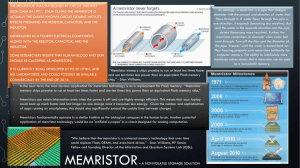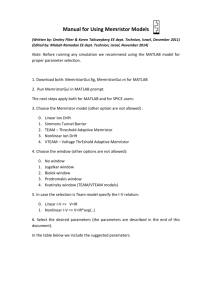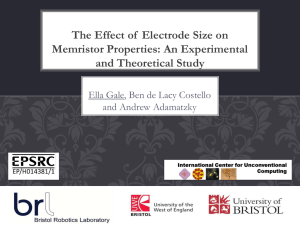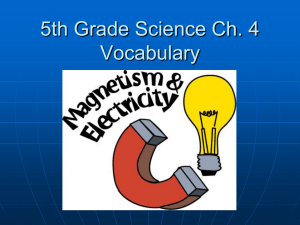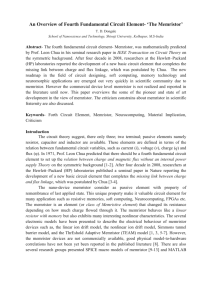NonlinearDynamicsAndEmbeddedFPGASystems
advertisement
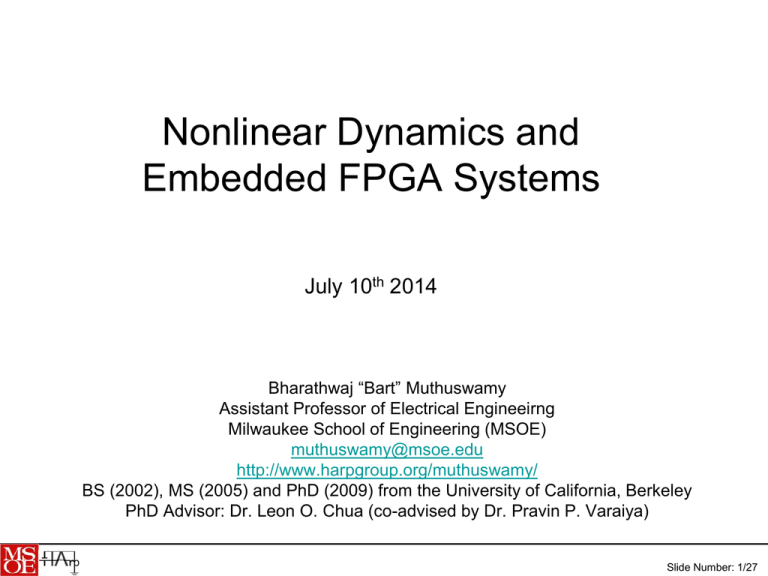
Nonlinear Dynamics and Embedded FPGA Systems July 10th 2014 Bharathwaj “Bart” Muthuswamy Assistant Professor of Electrical Engineeirng Milwaukee School of Engineering (MSOE) muthuswamy@msoe.edu http://www.harpgroup.org/muthuswamy/ BS (2002), MS (2005) and PhD (2009) from the University of California, Berkeley PhD Advisor: Dr. Leon O. Chua (co-advised by Dr. Pravin P. Varaiya) Slide Number: 1/27 What do I work on? Nonlinear Dynamical Systems and Embedded Systems - Physical Memristors: discharge tubes, PN junctions and Josephson Junctions (MSOE; IIT Chennai; University of Western Australia, Perth, Australia; Vellore Institute of Technology (VIT), Vellore, India) - Applications and Mathematical properties of the Muthuswamy-Chua system (MSOE; VIT; University of Western Australia; AGH-University of Science and Technology, Poland) - Applications of Chaotic Delay Differential Equations using Field Programmable Gate Arrays (FPGAs) (MSOE; VIT; University Putra Malaysia, Malaysia ) - Pattern Recognition Using Cellular Neural Networks on FPGAs (MSOE; VIT; Altera Corporation) Education - Nonlinear Dynamics at the undergraduate level (with folks from all over the world ) Slide Number: 2/27 Primary Goal of this Talk Overview of my research interests Slide Number: 3/27 Outline I. Background 1. The Question of Applications 2. The Science and Art of Device Modeling II. The Memristor 1. The Fundamental Circuit Elements 2. Properties of the Memristor 3. Memristive Devices 4. Memristor Emulator 5. Physical Memristors a. Non-ideal Memristors: i. Discharge tube ii. Junction diode b. Ideal memristor: i. Josephson junction III. The Muthuswamy-Chua System (Circuit) IV. FPGA Based Nonlinear Dynamics 1. Chaotic Systems 2. Pattern (Image) Recognition V. Conclusions, Current (future) work and References Slide Number: 4/27 The Question of Applications Scientific discoveries and inventions have only been achieved by those who went in pursuit of them without any applications in mind - Max Planck Who was Max Planck? Slide Number: 5/27 The Science and Art of Device Modeling We first have to understand that a circuit model is not an equivalent circuit of a device since no physical device can be exactly mimicked by a circuit or mathematical model [9]. In fact, depending on the application (e.g., frequency of operation), a given device may have many distinct physical models [9]. There is no ”best model” for all occasions. The best model in a given situation is the simplest model capable of yielding realistic solutions [9]. Thus device modeling is both an art (physical device equation formulation) and science (nonlinear network synthesis). Slide Number: 6/27 Outline I. Background 1. The Question of Applications 2. The Art and Science of Device Modeling II. The Memristor 1. The Fundamental Circuit Elements 2. Properties of the Memristor 3. Memristive Devices 4. Memristor Emulator 5. Physical Memristors a. Non-ideal Memristors: i. Discharge tube ii. Junction diode b. Ideal memristor: i. Josephson junction III. The Muthuswamy-Chua System (Circuit) IV. FPGA Based Nonlinear Dynamics 1. Chaotic Systems 2. Pattern (Image) Recognition V. Conclusions, Current (future) work and References Slide Number: 7/27 The Fundamental Circuit Elements v v f (i) q g (v ) q i s (q) h(i) Φ Memristors were first postulated by Leon. O Chua in 1971 [2]. In 2008, researchers at HP claimed to have found the “missing” memristor [11]. Slide Number: 8/27 Properties of the Memristor [2] [4] Circuit symbol: A memristor defines a relation of the from: g ( , q) 0 (1) If g is a single-valued function of charge (flux), then the memristor is charge-controlled (flux-controlled) Memristor i-v relationship: v(t ) @ M(q(t)) is the incremental memristance d d dq @ M (q(t ))i(t ) dt dq dt (2) d dq q Q1: Why is the memristor called “memory resistor”? t Because of the definition of memristance: v(t ) M (q(t ))i (t ) M i ( ) i (t ) (3) Q2: Why is the memristor not relevant in linear circuit theory? 1. If M(q(t)) is a constant: v(t ) M (q(t ))i(t ) Mi(t ) Ri(t ) (4) 2. Principle of superposition is not* applicable. Proof: t t t t t M (i1 i2 )( ) (i1 i2 )(t ) M (i1 )( ) (i1 )( ) (i1 i2 )(t ) M (i1 )( ) i1 (t ) M (i2 )( ) i2 (t ) Slide Number: 9/27 Memristive Devices [4] r v @ R ( z , i )i r& r z f ( z , i) r r z @q, R( z , i) @M (q) (5) v @ M (q)i q& i (6) The functions R and f are defined as: R:¡ n ¡ ¡ f :¡ n ¡ ¡ n r In Eq. (5), R( z , i) Slide Number: 10/27 Memristor Emulation [8] Slide Number: 11/27 Memristor Emulation : Passive Elements only [5] (7) (8) (9) (10) (11) Slide Number: 12/27 Memristor Emulators – Pinched Hysteresis Loops [8] [5] From [3], pinched-hysteresis for 3 kHz sinusoidal input From [4] From [3], pinched-hysteresis for 35 kHz sinusoidal input Slide Number: 13/27 Non-ideal Memristor : Discharge Tube [9] v M (n)i n& n M (n)i 2 (12) F M ( n) @ n (13) Slide Number: 14/27 Non-ideal Memristor : Junction Diode [3] (15) (14) Slide Number: 15/27 Ideal Memristor : Josephson Junction [6] [10] E h (16) h 2 d i h dt d 2e v h dt 2e d v h dt d 2e = v (17) dt h Slide Number: 16/27 Ideal Memristor : Josephson Junction (contd.) Suppose v = 1 uV. f (in Hz) for the Josephson junction d dt f = 0.482 GHz! 2e (1 V ) h 2e (1 V ) h 482 MHz 2 d B dt = B h @ k 2e v (18) Slide Number: 17/27 Ideal Memristor : Josephson Junction (contd.) 2e 2e I I (v) sin B + 0 (v) 1 (v) cos B v h h (19) Slide Number: 18/27 Ideal Memristor : Josephson Junction (contd.) Slide Number: 19/27 Outline I. Background 1. The question of Applications 2. The Art and Science of Device Modeling II. The Memristor 1. The Fundamental Circuit Elements 2. Properties of the Memristor 3. Memristive Devices 4. Memristor Emulator 5. Physical Memristors a. Non-ideal Memristors: i. Discharge tube ii. Junction diode b. Ideal memristor: i. Josephson junction III. The Muthuswamy-Chua System (Circuit) IV. FPGA Based Nonlinear Dynamics 1. Chaotic Systems 2. Pattern (Image) Recognition V. Conclusions, Current (future) work and References Slide Number: 20/27 The Muthuswamy-Chua Circuit [8] vM @ R( z, iM )iM z& f ( z, iM ) Circuit equations: v&c i 'L iL C System equations: x @vc , y @iL 1 vC R( z, iL )iL L z&@ f ( z, iL ) (20) y C 1 y& x R ( z , y ) y L z& f ( z , y ) x& (21) Specifically: y C 1 y& x ( z 2 1) y L z& y z yz x& Parameters: C 1, L 3 (22) 3 3 = , = 2 5 Slide Number: 21/27 Outline I. Background 1. The question of Applications 2. The Art and Science of Device Modeling II. The Memristor 1. The Fundamental Circuit Elements 2. Properties of the Memristor 3. Memristive Devices 4. Memristor Emulator 5. Physical Memristors a. Non-ideal Memristors: i. Discharge tube ii. Junction diode b. Ideal memristor: i. Josephson junction III. The Muthuswamy-Chua System (Circuit) IV. FPGA Based Nonlinear Dynamics 1. Chaotic Systems 2. Pattern (Image) Recognition V. Conclusions, Current (future) work and References Slide Number: 22/27 FPGA Based Nonlinear Dynamics: Chaotic Systems [12] x& f (x, x(t )) (23) x& sin( x(t )) x(t ) (24) Slide Number: 23/27 FPGA Based Nonlinear Dynamics: Pattern (Image) Recognition Utilize ideas behind the retinal hypercircuit (Werblin Lab, Berkeley) for recognition of hand-drawn circuit diagrams Slide Number: 24/27 Conclusions • Overview of my research • Memristors • Chaos • FPGAs Slide Number: 25/27 Current and Future Work 1. Understanding v-i characteristics of discharge tube: Circuit for plotting v-i (with Dr. Iu (UWA), Dr. Loo (HKP)) 2. Chaos in Muthuswamy-Chua with discharge tube [1] (with Dr. Iu, Dr. Loo and Dr. Corinto (Politecnico di Torino)) 3. Identifying ideal memristive behavior in the Josephson junction (with IIT-Chennai and VIT) 4. Complete SPICE model of junction diode with memristor (with Dr. Jevtic (MSOE) ) • Specifically for 3. and 4., use the idea of frequencypower formulae? 5. An electromagnetic field (physical) theory for memristors (with Dr. Jevtic and Dr. Thomas (MSOE)). 6. FPGA Based Nonlinear Dynamics: Pattern Recognition Slide Number: 26/27 References 1. 2. 3. 4. 5. 6. 7. 8. 9. 10. 11. 12. Braun, T. et. al. “Observation of Deterministic Chaos in Electrical Discharges in Gases”, Physical Review Letters, Vol. 59, No. 6, pp. 613-616, 1987. Chua, L. O. “Memristor-The Missing Circuit Element”. IEEE Transactions on Circuit Theory, Vol. CT-18, No. 5, pp. 507- 519. September 1971. Chua, L. O. and Tseng, C. “A Memristive Circuit Model for P-N Junction Diodes”. Circuit Theory and Applications. Vol. 2, pp. 367-389, 1974. Chua, L. O. and Kang, S. M. “Memristive Devices and Systems”. Proceedings of the IEEE, Vol. 64, No. 2, pp. 209- 223. February 1976. Corinto, F. and Ascoli, A. “Memristive Diode Bridge with LCR Filter”. Electronics Letters, Vol. 48, No. 14, pp.824–825, DOI: http://dx.doi.org/10.1049/el.2012.1480. Josephson, B. “Supercurrents through Barriers”. Advances in Physics, Vol. 14, No. 56, pp. 419 – 451, 1965. Mader, U. and Horn, P. “A Dynamic Model for the Electrical Characteristics of Fluorescent Lamps”, IEEE Industrial Applications Society – Annual Meeting, Vol. 2, pp. 1928 – 1934, 1992. Muthuswamy, B. and Chua, L. O. “Simplest Chaotic Circuit”. International Journal of Bifurcation and Chaos, vol. 20, No. 5, pp. 1567-1580. May 2010. Muthuswamy, B. et. al. “Memristor Modelling”. Proceedings of the 2014 International Symposium on Circuits and Systems, Melbourne, Australia, June 1st – 5th 2014. Penfield, P. “Frequency Power Formulas for Josephson Junctions”. MIT Technical Report – Micrometer and Millimeter Wave Techniques, QPR 113, 1973. Strukov, D. B., Snider, G. S., Steward, D. R. and Williams, S. R. “The missing memristor found”. Nature, vol. 453, pp. 81-83, 1st May 2008. Valli, D. et. al. “Synchronization in Coupled Ikeda Delay Systems – Experimental Observations Using Field Programmable Gate Arrays”. European Physical Journal: Special Topics. DOI: 10.1140/epjst/e2014-02144-8, 2014. MANY THANKS TO DR. JEVTIC AND DR. THOMAS (MSOE) Questions and Discussion… Slide Number: 27/27

